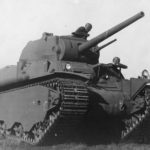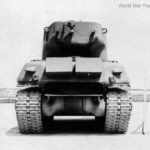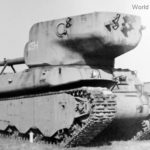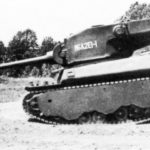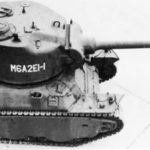T1E2 at Baldwin Locomotive Works side view, December 1941
T1E2 pilot tank being tested December 1941
T1E2 (M6) at Baldwin Locomotive Works, December 1941 2
Heavy Tank M6A2E1 at Aberdeen Proving Ground
Rear side of the M6A2E1
Heavy tank M6A2E1 #1
Front side of the M6A2E1 #1
Heavy tank M6
M6A2E1 Number 2 at Aberdeen Proving Ground
M6A2E1 Number 1 at Aberdeen 1945
M6 and M5 Stuart tank size comparison
M5 Stuart #115 and M6 tanks at Fort Knox 1943
M6A2E1 tank
Heavy Tank T1E2
During the inter-war period, due to budget cuts, the USA had only a small number of tanks in service. This also consisted of light and mostly obsolete types. The great successes of the German tank divisions on the ETO, at the beginning of the Second World War, caused a rethink in this sector. Several development programs have now been commissioned for various tank types, including the M4 Sherman, the M3 Stuart and the M6 Heavy Tank. After initial development work, a multitower concept called T1 was awarded the contract. Three months later, however, it was decided to abandon the concept in favour of a single-tower construction. This version had a long, vertically stabilized 76mm gun and a coaxial 37mm gun built into a large turret. In addition, there were three 12.7 mm and two 7.62 mm MGs. In addition, various drive concepts were tested. Two of the first three prototypes were fitted with a normal geared motor with torque converter (M6A1), the third one with an electric drive (M6A2).
After completion of the construction work, U.S. Army lost interest in a heavy tank. Army were not impressed with the new tank and, after testing, concluded that it was too heavy, did not have a large enough main armament and suffered from transmission problems. Medium tanks were more mobile with only slightly thinner armour and almost the same armament. They were a much smaller target and were also cheaper to produce. Nevertheless, an order of 5000 units (250 units per month) was placed. However, several cuts meant that no more than 40 units left the factory. After all, the medium tanks fulfilled all the tasks and up to the M26 Pershing there should be no heavy tanks in the U.S. armoured forces. In all, 8 M6, 12 M6A1 and 20 M6A2 were built by Baldwin Locomotive between November 1942 and February 1944. They were never issued to operational units but were used for trials within the United States.


